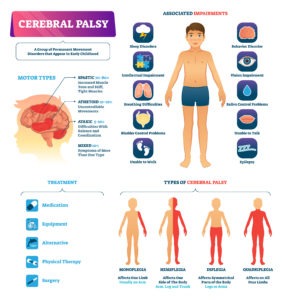
Athetoid cerebral palsy, also known as choreoathetoid cerebral palsy, can have significant impacts on your child’s life. They may require ongoing therapy, medical care, and other support. If a doctor’s negligence caused their brain injury and this condition, you may be able to hold the doctor or hospital liable and recover compensation to cover your child’s lifelong care.
Call the Birth Injury Lawyers Group today. You can connect with a cerebral palsy lawyer from your state who will review your case at no cost to you. If you have a strong case for medical malpractice, your attorney will pursue a payout on your behalf.
Athetoid Cerebral Palsy Lawsuits
To recover damages in a medical malpractice case based on your child’s birth injury and athetoid cerebral palsy diagnosis, you, with the help of your attorney, will need to prove the doctor failed to provide an acceptable standard of care, engaged in medical negligence, and caused your newborn to suffer preventable birth injuries. Your attorney knows what it takes to navigate this type of case and fight for the compensation you deserve.
Recoverable damages in an athetoid cerebral palsy birth injury lawsuit include:
- Medical care costs related to the child’s diagnosis
- Ongoing and future care costs
- Therapy costs
- Adaptive equipment, mobility aids, and communication devices
- Prescription drug costs
- Out-of-pocket costs, such as the expenses to make your home wheelchair accessible
- Pain and suffering damages
- Other noneconomic damages
State law only gives you a limited time to take action in a medical malpractice case. Reach out to an attorney in your state today to learn more.
Athetoid Cerebral Palsy Overview
Athetoid cerebral palsy is a type of dyskinetic cerebral palsy. As such, the primary symptom is involuntary movements that vary between being jerky and abrupt or slow and writhing.
Athetoid Cerebral Palsy Causes
Athetoid cerebral palsy occurs because of damage to the basal ganglia area of the brain. This part of the brain is responsible for controlling and coordinating movement. Damage to this area not only makes it difficult to coordinate voluntary movements, but it can also cause involuntary and unwanted movements. In the case of athetoid cerebral palsy, this is primarily athetosis—a specific type of slow, writhing movements.
What causes the initial damage to the brain can vary. The brain injury may be from a maternal infection, a neonatal stroke, a traumatic injury, or a complication that cut off the oxygen or blood flow to the basal ganglia.
Athetoid Cerebral Palsy Symptoms
As with all types of dyskinetic cerebral palsy, people with athetoid cerebral palsy exhibit uncontrolled muscle movements. When someone with athetoid cerebral palsy tries to move, their body creates other movements instead. In this type of condition, the unwanted movements usually consist of athetosis (slow, writhing movements) and chorea (abrupt, jerking movements). This gives rise to the other name of the condition, choreoathetoid cerebral palsy.
Athetoid Cerebral Palsy Diagnosis and Treatment
Your child’s doctor may have a good idea of the diagnosis based on witnessing the involuntary movements characteristic of athetoid cerebral palsy. However, to officially diagnose your infant or toddler, the doctor will evaluate:
- The child’s development compared to their peers
- Their reflexes
- How they move and the ability to control their movement
- Changes in muscle tone
The doctor may identify the damaged area of the brain by ordering a brain MRI, CT scan, or ultrasound and rule out additional conditions with blood and urine tests.
Electroencephalography (EEG) and electromyography (EMG) are sometimes used to determine the severity of the condition. In addition, the doctor will likely order tests such as hearing and vision screenings to rule out common coexisting conditions.
Treatments for athetoid cerebral palsy vary based on severity. They often include:
- Physical therapy
- Occupational therapy
- Speech therapy
- Medications
- Braces and other orthotic devices
For older children who cannot walk or talk, there are a number of options for mobility, including wheelchairs, gait trainers, crutches, and rolling walkers. There are also communication aids such as tablets and computers equipped with a voice synthesizer.
Athetoid Cerebral Palsy Frequently Asked Questions
How do I know if my baby has athetoid cerebral palsy?
Cerebral palsy is often first identified when an infant fails to meet milestones when their peers do and experience developmental delays. While many children are not sitting up, crawling, walking, and talking as early as their peers, this combined with awkward or abnormal movements may point toward an athetoid cerebral palsy diagnosis.
Can athetoid cerebral palsy be fatal?
In the vast majority of cases, athetoid cerebral palsy will not be fatal. It is also not progressive, meaning your child will not get worse. However, it does require ongoing treatment and support.
Who is liable for athetoid cerebral palsy?
When you talk to a birth injury attorney in your state about your case, they can help you identify the liable party. In most cases, it will be the doctor who monitored your child throughout pregnancy and delivered him at the hospital.
What is the statute of limitations for athetoid cerebral palsy?
The statute of limitations and statute of repose that apply in your athetoid cerebral palsy birth injury case depend on the state where your child was born. Your attorney can explain the laws that put a deadline on how long you have to take legal action, as well as if the state allows tolling of the limit for minors.
Athetoid Cerebral Palsy Glossary Terms
- What Is Athetosis?: Athetosis is a condition characterized by abnormal muscle contractions that cause the person to appear to be writhing. It is common in athetoid cerebral palsy and often makes it difficult to talk using the hands.
- What Is the Basal Ganglia?: The basal ganglia is the area of the brain that coordinates and controls movements. Athetoid cerebral palsy generally occurs because of damage to the basal ganglia.
- What Is Dyskinetic Cerebral Palsy: Dyskinetic cerebral palsy is a form of cerebral palsy characterized by variable, involuntary movement. Athetoid cerebral palsy is a type of dyskinetic cerebral palsy.
A Birth Injury Attorney Can Help You Understand Your Rights
If your baby has a diagnosis of athetoid or choreoathetoid cerebral palsy, they may have this condition because of a medical error, birth injury, or medical neglect. A medical malpractice attorney can help you find out if medical malpractice played a role in your child’s disability and pursue a case against the liable doctor or hospital.
Reach out to the Birth Injury Lawyers Group by calling 1-800-222-9529. You can connect with a birth injury lawyer in your state for a free case review.
